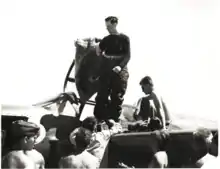Jack Woolams
Jack Valentine Woolams (1917–1946) - was the senior experimental test pilot and later chief test pilot at Bell Aircraft during the introduction of the P-39, P-63, P-59, and X-1 aircraft. He set a world record for altitude and was the first person to fly a fighter jet non-stop across the United States.
Jack Woolams | |
|---|---|
 Woolams after setting an altitude record of 47,600ft in a P-59 | |
| Born | February 14, 1917 |
| Died | August 30, 1946 (aged 29) |
| Cause of death | Plane Crash |
| Nationality | American |
| Known for | Test Pilot |
| Aviation career | |
| Famous flights | First pilot to fly the Bell X-1 |
Early life
Woolams was born on February 14, 1917 (Valentine's Day) to Leonard and Elsa Woolams in San Francisco, CA and raised in the suburb of Ross, California.[1] Woolams attended the University of Chicago for two years before joining the United States Army Air Corps. He served on active duty for approximately eighteen months, after which he returned to the University of Chicago and graduated with a degree in economics in June 1941.
Career and flight records
Woolams joined Bell Aircraft later that month and was soon transferred from the test flight division to the experimental research division. In September 1942, he became the first person to fly a fighter aircraft coast to coast over the United States without stopping.[2] In the summer of 1943, he set a new altitude record of 47,600 feet.[3] He became chief test pilot for Bell in 1944. Woolams was the first pilot to fly the Bell X-1 and the only pilot to fly the rocket-plane at Bell's research facility at Pinecastle Army Airfield in Orlando, Florida.
Personality
Woolams was known as a bit of a practical joker. While flying the still unknown experimental P-59 jet airplane, he would join formation with unsuspecting pilots flying propeller-driven fighters and to their surprise, wave at them while wearing a gorilla mask, bowler hat, and cigar, and then fly away leaving them behind.[4]
Death and legacy
Woolams died on August 30, 1946 in the crash of the modified P-39 Cobra I race-plane during a practice flight for the National Air Races in Cleveland, Ohio that were to occur the next day. Woolams flew the Cobra I from Cleveland back to Bell Aircraft in Niagara Falls on August 29, after obtaining a disappointing qualifying speed of 392 mph. Woolams was testing the plane over Lake Ontario late in the afternoon at speeds over 400 mph when it suddenly and inexplicably crashed into the water, breaking apart upon impact. His body was recovered 4 days later.[2] After the wreckage of Cobra I was recovered, it was believed a canopy failure was the cause of the crash and Woolams' death.[5]
There was internal debate at Bell Aircraft as whether to continue with the race or not, but Woolams' teammate and fellow Bell test pilot, Tex Johnston, insisted that Woolams would have raced if it was the other way around.[5] The day after Woolams' death, Johnston went on to win the 1946 Thompson Trophy in the Cobra II, the identical twin of Cobra I.[5]
References
- "United States Census, 1930". FamilySearch.com. Retrieved 20 September 2020.
- "X-1 Biographies". NASA. Retrieved 14 January 2013.
- "Jack Woolams Establishes an Altitude Record". Edwards Air Force Base. Retrieved 20 September 2020.
- Sterling Michael Pavelec (2007). The Jet Race and the Second World War. Greenwood Publishing Group. pp. 133. ISBN 978-0-275-99355-9.
- Johnston, Tex. Tex Johnston, Jet-Age Test Pilot (1st ed.). Washington D.C.: Smithsonian Institution Press. p. 85-99. ISBN 1-56098-013-3.
External links
![]() This article incorporates public domain material from the United States Government document: "https://history.nasa.gov/x1/woolam.html".
This article incorporates public domain material from the United States Government document: "https://history.nasa.gov/x1/woolam.html".